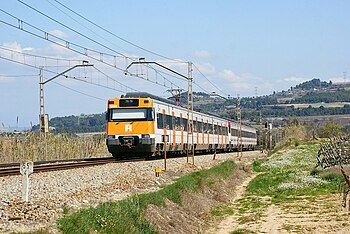Barcelona – Martorell – Tarragona railway line
| Barcelona – Martorell – Tarragona | |
|---|---|
|
Class 447 double traction at Lavern-Subirats
| |
| Route number : | 220 (Barcelona – L'Hospitalet de Llobregat) 240 (L'Hospitalet de Llobregat – Sant Vicenç de Calders) 600 (Sant Vicenç de Calders – Tarragona) |
| Route length: | 99 km |
| Gauge : | 1668 mm ( Iberian track ) |
| Power system : | 3 kV = |
| Top speed: | 160 km / h |
| Train control : | ASFA |
| Further gauge: | 1435 mm ( standard gauge ) Bif. Llobregat – Bif. Rubí (one line track) ( three- rail track ) |
The Barcelona – Martorell – Tarragona railway is an electrified, broad-gauge railway in Spain. The operator is the state-owned Spanish railway infrastructure company Adif . The route is part of the Corredor Mediterráneo (Mediterranean Corridor).
history
| Opening date | Route section |
|---|---|
| November 26, 1854 | Barcelona - Molins de Rei |
| November 10, 1856 | Molins de Rey-Corominas |
| June 23, 1859 | Corominas - Martorell |
| April 15, 1865 | Martorell - Tarragona |
With the opening of the first Spanish railway line between Barcelona and Mataró in 1848, the railway network around the Catalan capital grew steadily. In 1850 the engineer Michael de Bergue was granted the concession to build a railway line between Barcelona and Molins de Rei. The first section to Molins de Rei was put into operation in 1854, and in 1859 it was extended to Martorell . Even before the opening of the first section, it became clear that the railway line would not be economically viable. In 1852, plans for further route extensions began. The Camino de Hierro del Centro railway company, founded in 1853, favored a possible route to Valls . The early phase of Spanish railway history was characterized by numerous new construction projects by competing companies. So the Camino de Hierro del Centro only received the concession to build a railway line to Tarragona . Valls was only opened up in 1883 on the coastal line La Plana - Picamoixons - Barcelona by the competitor Compañía de los Ferrocarriles Directos de Madrid y Zaragoza a Barcelona . During this time the new crossing station Sant Vicenç de Calders was built. The entire line was later expanded to double tracks and electrified in the 1950s.
Route description
The route begins with the junction to La Plana - Picamoixons, just beyond Barcelona's city limits in L'Hospitalet de Llobregat . After the Cornellá train station , the route turns north-west and follows the Llobregat river valley on the left bank of the river. After a tunnel behind Castellbisbal , the Llobregat is crossed and the Martorell train station is reached. In the mid-1980s, the railway line was covered within the urban area and built over by a road. Behind Martorell, the route essentially follows the AP-7 motorway to Vendrell . The high-speed line Madrid – Barcelona – French border also runs behind Martorell and El Vendrell for the most part alongside the existing line and is crossed under several times. With the construction of the high-speed line, the station of Vilafranca del Penedès and part of the old line were also moved underground. After El Vendrell, the route leads towards the Mediterranean Sea to the Sant Vicenç de Calders junction station. The stretch southwest from Sant Vicenç de Calders to Tarragona is mostly in close proximity to the coast.
business
Passenger traffic takes place along the entire length of the route, the section between Barcelona and Sant Vicenç de Calders is served by the R4 line of Rodalies Barcelona . . Between Molins de Rei and in L'Hospitalet de Llobregat, the suburban traffic to Barcelona is supplemented by the R1 and R3 lines. The western section, between Sant Vicenç de Calders and Tarragona, is served by regional trains. The SEAT plant in Martorell is particularly important for freight transport, as is the rail link to the port of Barcelona .
Planning
Major construction work is currently taking place between the Castellbisbal and the connection to the SEAT plant in Martorell. Here, an old railway tunnel is reactivated, which was shut down in 1980 after a route was relocated due to the double-track expansion. The future three main lines are on three-rail tracks rebuilt and the (1435 mm) and Iberian broad gauge allow the operation to standard gauge (1668 mm). With 250 train journeys per day, the junction is considered to be the busiest in Spain.
As part of the Corredor Mediterráneo project , the entire line is to be upgraded to four tracks in the long term and converted to standard gauge.
Remarks
- ↑ Beginning of the three-rail track (1435/1668 mm)
- ↑ End of three-rail track (1435/1668 mm)
- ↑ today Castellbisbal
Web links
Individual evidence
- ↑ Cronología básica del ferrocarril español de vía ancha. (PDF) http://docutren.com/ , accessed February 27, 2020 (Spanish).
- ↑ 150 años del ferrocarril de Barcelona a Molins de Rei y Martorells. http://www.vialibre-ffe.com/ , accessed on February 27, 2020 (Spanish).
- ↑ 150 años del ferrocarril de Tarragona a Martorell. http://www.150ftm.cat/ , accessed February 27, 2020 (Spanish).
- ↑ EL FERROCARRIL COMO ELEMENTO ESTRUCTURADOR DE LA MORFOLOGÍA URBANA La línea de ferrocarril de Barcelona a Vilanova y Valls. http://www.ub.edu , accessed February 27, 2020 (Spanish).
- ↑ TRINCHERA de la RENFE (Martorell). NÚRIA AMAT (1982). http://nagfoto.blogspot.com/ , accessed February 27, 2020 (Spanish).
- ^ R4 Sant Vicenç de Calders-Manresa. http://www.trenscat.com/ , accessed February 27, 2020 (Catalan).
- ↑ Adif finalizará la rehabilitación del antiguo túnel de Castellbisbal en junio de 2020. http://elmercantil.com/ , accessed on February 27, 2020 (Spanish).
- ↑ Arranca el tramo decisivo del corredor mediterráneo. http://www.lavanguardia.com/ , accessed February 27, 2020 (Spanish).
- ↑ ¿CUÁL ES EL ESTADO ACTUAL DEL CORREDOR MEDITERRÁNEO? http://elcorredormediterraneo.com , accessed February 27, 2020 (Spanish).


